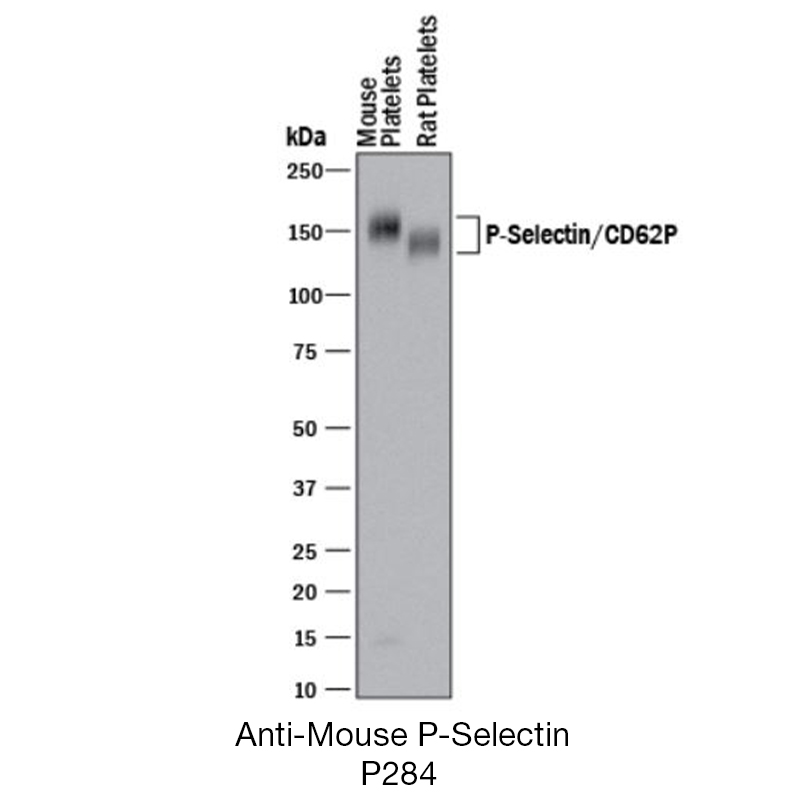Anti-Mouse P-Selectin
Anti-Mouse P-Selectin
Product No.: P284
- -
- -
Target P-Selectin Product Type Polyclonal Antibody Alternate Names Plasma Selectin, SELP, CD62, CD62P, FLJ45155, Granule Membrane Protein (GMP140), GRMP, Platelet Activation-Dependent Granule to External Membrane Protein (PADGEM), PSEL Applications IHC , WB |
Data
- -
- -
Antibody DetailsProduct DetailsReactive Species Mouse Host Species Goat Immunogen NS0-Derived Recombinant Mouse P-Selectin Extracellular Domain Endotoxin Level <0.1 EU/µg as determined by the LAL method Formulation This antigen affinity purified polyclonal antibody has been 0.2 µm filtered and lyophilized from modified Dulbecco’s phosphate buffered saline (1X PBS) pH 7.2 – 7.3 containing 5.0% w/v trehalose with no calcium, magnesium, or preservatives present. State of Matter Lyophilized Storage and Handling The lyophilized antigen affinity purified polyclonal antibody can be stored desiccated at -20°C to -70°C for twelve months from date of receipt. The reconstituted antibody can be stored for at least four weeks at 2-8°C. For long-term storage of the reconstituted antibody, aseptically aliquot into working volumes and store at -20°C to -70°C in a manual defrost freezer. Avoid Repeated Freeze Thaw Cycles. No detectable loss of activity was observed after six months. Country of Origin USA Shipping Next Day Ambient RRIDAB_2831580 Applications and Recommended Usage? Quality Tested by Leinco Western Blotting: To detect Mouse P-Selectin this polyclonal antibody can be used at a concentration of 0.1 - 0.2 µg/ml. This polyclonal antibody should be used in conjunction with compatible second-step reagents such as PN:G505 and a chromogenic substrate such as PN:T343. The detection limit for Mouse P-Selectin is 0.5 ng/lane under either reducing or non-reducing conditions. The sensitivity of detection may increase up to 50 fold when a chemiluminescent substrate is used. Simple Western: Suitable for use at concentration of 20 µg/mL. Additional Applications Reported In Literature ? Immunohistochemistry: Suitable for use at concentration of 5-15 µg/mL. Each investigator should determine their own optimal working dilution for specific applications. See directions on lot specific datasheets, as information may periodically change. DescriptionDescriptionSpecificity Goat Anti-Mouse P-Selectin recognizes Mouse P-Selectin. This antigen affinity purified polyclonal antibody was purified using a proprietary chromatographic technique that includes covalently immobilizing the antigen proteins or peptides to agarose based beads. This purification method enhances specificity, reduces nonspecific binding of extraneous IgG and provides you with the most reliable reagent available for your early discovery research. Background Plasma Selectin (P-selectin) is a cell adhesion molecule (CAM) found in granules in endothelial cells (cells lining blood vessels) and activated platelets. P-Selectin is expressed on activated endothelium and platelets where it can bind monocytes, neutrophils, stimulated T cells, and platelets.1 P-selectin plays an essential role in the initial recruitment of leukocytes (white blood cells) to the site of injury during inflammation. When endothelial cells are activated by molecules such as histamine or thrombin during inflammation, P-selectin moves from an internal cell location to the endothelial cell surface. Thrombin is one trigger which can stimulate endothelial-cell release of P-selectin and recent studies suggest an additional Ca2+-independent pathway involved in release of P-selectin.2 P-selectin-mediated adhesion is an important factor in the development of early atherosclerotic lesions.1 PubMed NCBI Gene Bank ID UniProt.org References & Citations1. Wagner, DD. et al. (1997) J Clin Invest. 99: 1037 2. Cleator, JH. et al. (2006) Blood 107: 2736 Technical ProtocolsCertificate of Analysis |
Related Products
- -
- -
Prod No. | Description |
|---|---|
P267 | |
P284 | |
P260 | |
P302 | |
P295 | |
P288 |



